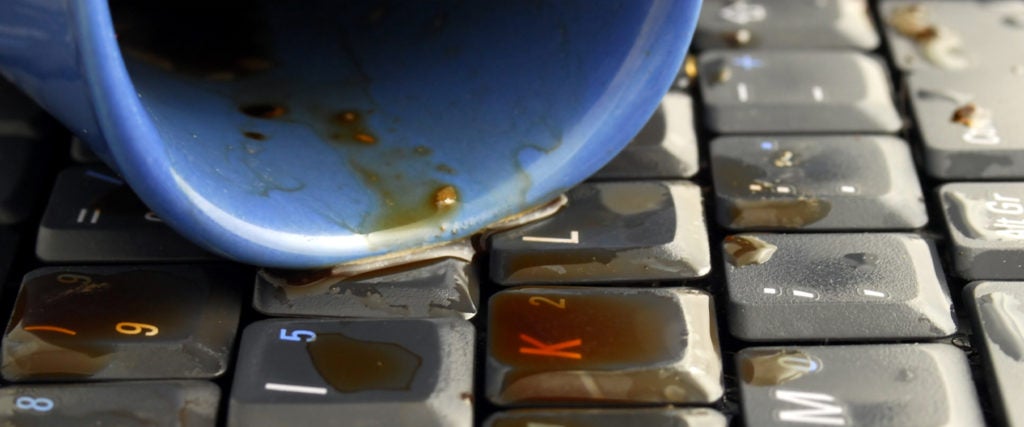Laptops and coffee are inextricably linked. Whether it’s a Starbucks full of freelancers, late-night caffeine-fueled coding sessions or hip creative meetings where everyone wields an exotic multi-prefixed drink that costs more than a nice pair of shoes, they’re frequently together. It seems absurd, then, that even in futuristic 2020, one measly cup can destroy a fucking computer.
There’s a real David-and-Goliath thing going on there, this low-tech, low-fi mug of ground-up beans and hot water — as simple as anything really gets, basically dirt — being capable of destroying a state-of-the-art, top-of-the-line machine. Similarly, a brand-new iPhone is a much-admired object of delicacy and beauty, while a toilet is a mundane and functional item, used daily but rarely celebrated. Nobody lines up around the block the day a new toilet model is released, the way they might do with a smartphone. And yet, a toilet has little to fear from a phone.
(Although, thinking about it, gravity is free and doesn’t even involve boiling a kettle, and dropping a laptop or smartphone off a mountain — the most low-tech thing you could possibly drop it off — will still totally fuck it, so maybe there’s less of a poetic irony involved in coffee-based technology destruction than I first thought.)
As for how liquids ruin electronics, it’s because they cause short circuits, diverting the electric currents within the gadget away from where they’re meant to go. If you’re lucky, you’ll get a grounding short, where currents are diverted somewhere that can handle them and everything just stops working, but if you’re less lucky, it’ll result in more power going through a circuit than the circuit can handle, leading to overheating or burnout. Some liquids bring extra complications with them: Seawater contains salt, which contains conductive ions that send current basically everywhere. Plus, when saltwater dries, it can leave a crust that continues to conduct electricity in ways you’d rather it didn’t. If you spill a drink on your electronics, sure, that sucks, but take a moment if you can to be grateful you weren’t drinking the ocean.
Now, as technology writer Natasha Stokes points out, “rugged” technology is available — chunky, impact-resistant, dust-resistant models mainly designed for use in industrial settings, fieldwork or military purposes. And while there’s something to be said for the kind of G-Shock chic these models have, they’re a far cry from the sleek aesthetics that have made a slender MacBook as much a fashion accessory as a computer. If a MacBook Air is a supermodel, the Dell Latitude Rugged Extreme is, let’s say, WWE wrestler Paul “The Big Show” Wight.
(Although it’s also really expensive — $3,500 — so perhaps it’s more like retired WWE legend Ted “Million Dollar Man” DiBiase.)
“Waterproofing a device, or providing water resistance beyond a liquid-repellent coating as some smartphones have, costs as a feature,” says Stokes. “When manufacturers are trying to keep phones and laptops at certain price points, water resistance hasn’t been prioritized over all those features that make our technology so great to use, like a good camera or graphics card, and thin, light hardware design.”
Waterproofing is expressed in technology using Ingress Protection codes: the letters IP followed by two digits. The first digit represents protection against solids and dust, and goes from zero to six, while the second represents protection against liquids and goes up to nine, but in an annoyingly complicated manner. One to six go up normally, increasing amounts of water exposure, but then things like water jets get involved and it all gets a bit silly. The iPhone 11 is rated IP68, for instance, which means it’s totally dust-proof and can in theory be submerged for half an hour. However, that isn’t covered by the warranty, so you can’t be entirely confident that a split-second of clumsy dumbassedness while peeing won’t cost you hundreds of dollars.
“There may be an element of manufacturers weighing the cost of water resistance against counting on a majority of users taking care of the device and/or not kicking up a fuss about its lackings,” says Stokes. “Take shock impact — back in the early days of iPhones, lots of people would drop their phones and crack the screens, leading to smartphone cases becoming the norm, rather than manufacturers making their phones less fragile.”
Phones are getting there — a few smartphone generations ago, the only models with anything approaching an IP68 rating were specialist ones — but a coffee to the laptop is still fairly catastrophic. Some models offer spill-resistant (i.e., coffee-proof) keyboards, but as a whole, a laptop is a lot more vulnerable than a phone. “Between fan vents, USB ports, HDMI ports and the keyboard, waterproofing a laptop presents more of a challenge, especially considering how heat needs to dissipate,” says Stokes.
Computer components generate heat as the transistors on its chips change states between on and off. Every change moves electricity around, resulting in a warmer and warmer computer. “Air vents are necessary to let heat escape from a laptop,” says Mohammad Asad of Computer Genius, a computer repair specialist in East London. “Your computer generates a lot of heat as it is working — the harder it’s working, the hotter it gets. This heat is transferred using a thermal compound to a heat sink, at which point it’s blown out of the vents by the fan, which stops the computer overheating. Without air vents, the computer will fry to death. It would be like you having a bag over your head — it basically suffocates.”
There’s no way around this at present, as eliminating the need for vents would pretty much mean reinventing how the inside of a computer works. The way forward for coffee-drinking computer users, then, might be that most low-tech of inventions — a lid.
It’s not stupid if it works, right?

